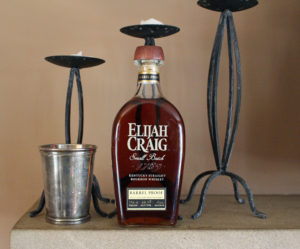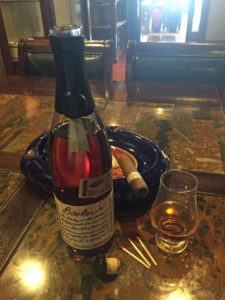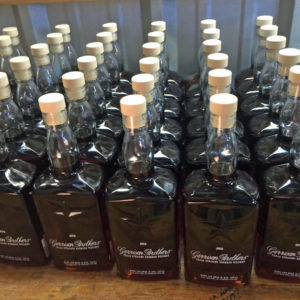Top Ten Bourbons Under $100
Updated December 3, 2022
By Richard Thomas

(Credit: Richard Thomas)
Although some magazines and websites revisit the subject of best whiskeys annually, I prefer to wait at least five years before tackling the subject again, at least under my own banner. It’s been almost five years for this particular round-up, so I am jumping the gun a little bit, but I have two good reasons for doing so.
First, bourbon prices were rising even before pandemic inflation set in. Although I pegged a mid-range bottle of bourbon as being $60 or less in 2018, nowadays I would set the mark at $75. I’ve written this up at $100 or less to give the article some legs, so I don’t need to revisit the subject in two years time.
My other reason is that my old article had two Buffalo Trace bourbons, Eagle Rare and Colonel E.H. Taylor Small Batch, on this list. Those two whiskeys are now showing the classic signs of hoarding-driven scarcity. Most regular release Buffalo Trace whiskeys are now unicorns at their official pricing, and their market value is two to four times higher than that, and this is assuming you can even find a bottle at all (to say nothing about their limited edition whiskeys!). I always try to offer practical advice in my writings, and those two Buffalo Trace whiskeys are not a practicable recommendation.
With that said, these are the ten best bourbons you can get for under $100. The prices listed reflect the market value for that bottle, based on an average taken from several retailers around the US.
1792 Full Proof ($70): For most American bourbon enthusiasts, higher proof means better whiskey, which probably explains the popularity of 1792 Full Proof. It’s not quite a cask strength whiskey; the “full proof” refers to bottling the bourbon at its entry proof, or the strength the new make spirit is cut to for pouring into the barrel. At Barton 1792 Distillery and for this line of bourbon, that is 125 proof. The result is a big bodied, mature bourbon that makes for outstanding rocks drinking.

(Credit: John Rayls)
Booker’s ($90): This classic cask strength bourbon has benefited from an interesting turn in 2022. Since it’s introduction some three decades ago, Booker’s has been billed as being between six and eight years of age. In recent years, that age statement has hovered around 6 1/2 years, but the 2022 batches have all been above 7 years. Booker’s is getting back to what it was when I first became acquainted with it: a cask strength bourbon so mellow that you’ll have no idea how strong it really is until you stand up from the bar stool.
Elijah Craig Barrel Proof ($75): As already described, cask strength whiskey has broad appeal among bourbon fans. Beyond that, this expression has one added plus for lovers of Elijah Craig in particular. Whereas Elijah Craig Small Batch has become a No Age Statement (NAS) bourbon, the barrel proof version continues in the original 12 year old formulation.
FEW Bourbon ($50): It’s not uncommon in craft circles to see most of the forerunners and early entrants evolve their production process over the years, tweaking this part and that. Insofar as I know, Evanston’s FEW Spirits is made the same way it was from the day it was introduced. Clearly, they got it right the first time.
Four Roses Single Barrel ($50): Four Roses is famous for their combination of five yeast strains and two mash bills, used to create ten distinct bourbons. The only way you get to know each of those ten is through Four Roses Single Barrel, because they two or more appear blended together in all other Four Roses expressions. The problem there is that if you are picky about what you like in your whiskey, you may come away disappointed with some of those ten versions of Four Roses. “It’s always a toss up as to what single barrel you’re going to get,” says Katie Buchanan, New York-based blues rocker, producer and bourbon enthusiast.
Knob Creek 12 Year Old ($70): Five years after the bourbon world went hysterical over the notion that newcomers would drink all the world’s aged whiskey, Jim Beam turned that around by reintroducing its classic Knob Creek 9 Year Old and then introducing this all new 12 Year Old expression. Some whiskeys become more sophisticated with age, while others develop more character. Knob Creek 12 Year Old is the later, as middle age makes Knob Creek mustier.

(Credit: John Rayls)
Garrison Brothers Small Batch ($80): One of the forerunners of the craft whiskey movement, Garrison Brothers faced the challenge of making bourbon in the fierce Texas climate, and made a virtue out of that necessity. The result was some of the ballsiest whiskey around. Their small batch expression is basically a renamed version of their Vintage releases that were covered by us in 2014 and 2015, as bold as it ever was.
Old Forester 1920 Prohibition ($60): Brown-Forman created this stuff to approximate what the company was selling as medicinal whiskey during the Prohibition years. The result was a bourbon made from a mash bill of 72% corn, 18% rye, and 10% malted barley and bottled at 115 proof. According to wine writer Michael Cervin, Old Forester 1920 has “plenty of fermented stone fruits, fruit, browned butter, cocoa crème brulee, and a potent nuttiness, and it just lingers, hovering around in your mouth.”
Russell’s Reserve Single Barrel ($70): The Wild Turkey fan favorite in this price range, Russell’s Reserve delivers on all points for fans of that distillery. It’s unmistakably Wild Turkey bourbon, coming from butter barrels and bottled at a markedly high, but not actually rocket fuel strength of 110 proof.
Woodford Reserve Double Oaked ($50): Introduced a decade ago, this was the original example of double new oak aging. By that, I mean using a second round of new white oak barrels for finishing the whiskey, instead of the used casks so frequently used for secondary maturation. Instead of introducing the new flavors of wine, rum, beer or some other liquor into the bourbon, finishing in new white oak doubles down on traditional bourbon flavors. I think double new oak bourbons make for excellent dessert drinking, and Woodford Reserve Double Oaked is the solid, readily available and affordable choice in the category.
For a more budget friendly slate of options, see our Top 10 bourbons under $35, posted earlier this year.




All these heavy hitters…and FEW.
I’m impressed with Uncle Nearst 1856 but, no mention and very good hooch!
We’re poised to review their new rye. It’s in the next bundle of bottles I’m taking out for field photography.
I’ve drank a boatload of bourbon from low end to the highest rated and highest priced. I can easily afford anything short of some rare auction bottles. I however have never spent over $100 on a bottle for myself. 10 times the price doesn’t mean 10 times the quality or flavor. Hard to find doesn’t mean great either. It’s all just a fad and bragging rights like fancy wines.
There is a lot of truth to that. But not the whole truth. Henry McKenna 10 Year Old Single Barrel used to be one of those $35 bottles that made the “best bargain buy” whiskeys composed by people like me. Now you can hardly find the thing. There are many such examples, especially from Buffalo Trace distillery.
Completely agree!
Thanks for the article. I’m now having trouble (in Houston TX) finding Bookers under $100.00. I would have liked to see Smoke Wagon on the list and I’m a fan of Uncle Nearest. I will try the Few and get into the Garrison Brother’s hype. Thanks again.
I’m curious as to the lack of respect Bakers 7 seems to get- not just here, but generally. I see the same names pop up over and over again, but not Bakers 7. Are my taste buds warped or is this $60 bourbon just not worth it?
Thanks
Good eye.
Baker’s 7 would have been on this list, except for the fact that Booker’s has moved back to its earlier style this year. I felt putting Baker’s and Booker’s on the same round-up would have been a bit too much, what with all the worthy candidates.
Big fan of the Old Forrester 1920!
That is my favorite Old Forester bourbon, smooth well balanced and a decent price.
Me too, sir! It is a fine bourbon.